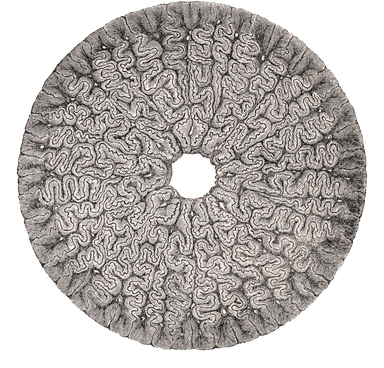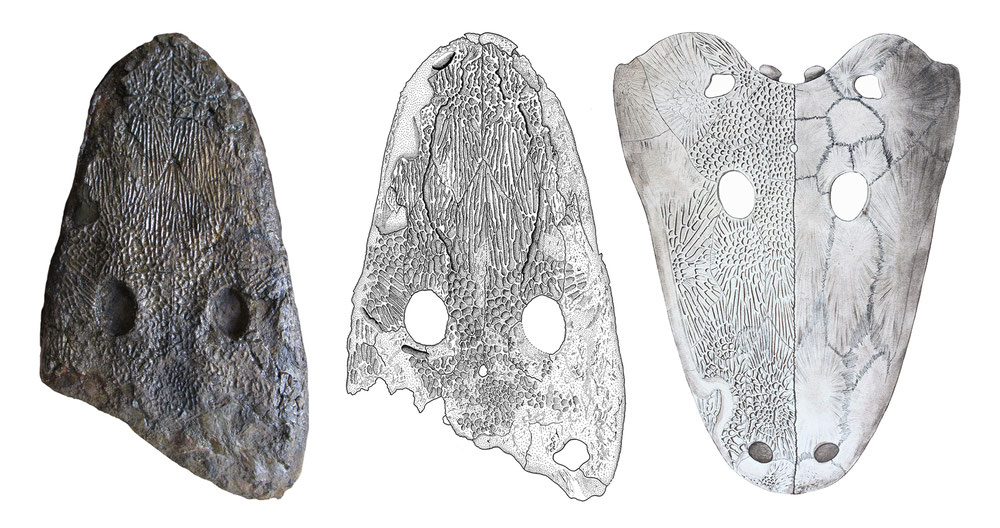Cyclotosaurus buechneri
A Triassic temnospondyl amphibian from Germany
by Sven Sachs & Florian Witzmann
Cyclotosaurus is a Triassic member of the Temnospondyli, a diverse group of
ancient amphibians that is well known from early Carboniferous to late Triassic stages and, with isolated records, also from Jurassic and early Cretaceous strata (Schoch & Milner 2000, 2014).
The term Temnospondyli was coined by Karl Alfred von Zittel (Zittel, 1887–1890) but in previous (and several later) publications the group was also called labyrinthodonts. This name refers to the
labyrintic pattern of dentine infolding that occurs in the cross-sections of their tooth crowns (see figure of a Mastodonsaurus tooth crown from Owen, 1860).

The genus Cyclotosaurus with the
type species Cyclotosaurus robustus was established in 1889 by Eberhard Fraas, then curator at the
Naturalienkabinet [Nature cabinet] (now Staatliches Museum für Naturkunde) in Stuttgart in his monograph „Die Labyrinthodonten der schwäbischen Trias“ [The labyrinthodonts of the Swabian
Triassic] (Fraas, 1889) where several temnospondyl finds from southwestern Germany are introduced.
Cyclotosaurus belongs to a large clade of mainly Triassic temnospondyls, the Stereospondyli. This is a diverse group of superficially crocodile-like aquatic forms among which the largest amphibians of earth’s history with a body length of more than five metres can be found (Schoch & Milner 2000). Stereospondyls were the top-predators in terrestrial ecosystems like rivers, swamps and lakes, but sometimes also occurred in brackish environments. Some stereospondyls have been found even in full marine assemblages (Steyer, 2002; Fortuny et al., 2018) or may have lived in habitats with changing salinity (Lindemann, 1991; Witzmann & Soler-Gijón, 2010).

Today we know that the genus had a wide distribution which is demonstrated by fossils from Europe, Thailand and Greenland (e.g.
Schoch, 2008; Marzola et al., 2017). Six species had been recognized until 2016: Cyclotosaurus robustus (Meyer & Plieninger, 1844) from the Late Triassic (upper Carnian) of
southwestern Germany (Baden-Württemberg); Cyclotosaurus mordax Fraas, 1913 from the Late Triassic (lower Norian) southern Germany (Baden-Württemberg and Bavaria); Cyclotosaurus
posthumus Fraas, 1913 from the Late Triassic (lower Norian) of southern Germany (Baden-Württemberg and Bavaria); Cyclotosaurus intermedius Sulej & Majer, 2005 from the Late
Triassic (upper Carnian) of Poland; Cyclotosaurus ebrachensis Kuhn, 1932 from the Late Triassic Blasensandstein of of southern Germany (Bavaria); Cyclotosaurus hemprichi Kuhn
1942 from the Late Triassic (upper Norian) of Central Germany (Saxony-Anhalt).
A seventh species, Cyclotosaurus buechneri, was established by Witzmann, Sachs & Nyhuis (2016a) based upon a largely complete skull from the Late Triassic (middle Carnian) Stuttgart Formation of Bielefeld in northwestern Germany and, in the meantime, even an eighth species Cyclotosaurus naraserluki Marzola, Mateus, Shubin & Clemmensen, 2017 has been established from Late Triassic (Norian) strata of Greenland (Marzola et al., 2017).
Brief history of the Cyclotosaurus buechneri find
The Cyclotosaurus buecheri skull was found in 1976 by an excursion of the Naturwissenschaftlicher Verein für Bielefeld und Umgegend [Natural History Society of Bielefeld and surroundings]. The excursion visited the Pape quarry in Bielefeld-Sieker which, at that time, served as a landfill for soil from the construction side of a new savings bank. The skull was discovered in the rubble by Martin Büchner, then director of the Natural History Museum in Bielefeld and leader of the excursion. Büchner saved the fossil and carried it to his museum where it is since part of the collection (for more information see Witzmann et al., 2016a, b). A tentative assignment to Cyclotosaurus was provided by Büchner himself. However, despite its completeness, it took 40 years from its discovery till the specimen was described in detail, although it was mentioned as Cyclotosaurus robustus in Schoch & Milner (2000) and Büchner (2008a, b).

Study by Florian Witzmann, Sven Sachs and Christian Nyhuis

A first inspection of the Bielefeld skull by Sven Sachs and Christian Nyhuis took place in 2013. As both had not much experience with temnospondyl fossils they invited Florian Witzmann to join the team. The specimen was revisited by us in 2014. During the course of our study it turned out that the Bielefeld Cyclotosaurus skull shows clear differences to other known specimens. In particular a combination of four characters is unique: the orbitae are medially placed and the interorbital distance is short; the portion lateral to orbitae is only slightly wider than width of orbitae; the postorbital part of the skull is slender, and the preorbital jugal projection is shorter than half the length of the snout (Witzmann et al., 2016a: p. 87).
Our phylogenetic analysis placed the Bielefeld specimen at the base of the Cyclotosaurus radiation. Now it was clear that we were dealing with a new species and so we decided to name it in honour of the finder and long-time curator of the Bielefeld Natural History Museum, Martin Büchner.
Implications of Cyclotosaurus buechneri
In Germany, stereospondyl amphibians are mainly known from Baden-Württemberg where they are common finds in Triassic continental deposits, however, they are exceptional in northern Germany (Schoch & Milner, 2000, 2014). Cyclotosaurus buechneri is the first undoubted representative of the genus Cyclotosaurus in northern Germany (Witzmann et al., 2016a, b).
3D model of the Cylotosaurus buechneri holotype
In 2017, Heinrich Mallison (Palaeo 3D) made a digital 3D model of the Cylotosaurus buechneri skull, which is available for download here.

Citations
Büchner, M. (2008a) Keuper-Sandsteine als Baumaterial in der Region zwischen Spenge und Melle. Jubiläumsband des
Naturwissenschaftlicher Verein für Bielefeld und Umgegend, 129–137.
Büchner, M. (2008b) Fest gefügt und wehrhaft. Das Mauergestein der Werburg in Spenge. Historisches Jahrbuch für den Kreis Herford 16, 145–148.
Fortuny, J., Gastou, S., Escuillié, F., Ranivoharimanana, L. & Steyer, J. S. (2018) A new extreme longirostrine temnospondyl from the Triassic of Madagascar: phylogenetic and palaeobiogeographical implications for trematosaurids. Journal of Systematic Palaeontology, 16: 675–688.
Fraas, E. (1889) Die Labyrinthodonten der schwäbischen Trias. Palaeontographica 36: 1–158.
Fraas, E. (1913) Neue
Labyrinthodonten aus der schwäbischen Trias. Palaeontographica 60: 275–294.
Kuhn, O. (1932) Labyrinthodonten und Parasuchier aus dem mittleren Keuper von Ebrach in Oberfranken. Neues Jahrbuch für Mineralogie, Geologie und Paläontolologie Abt. B. 69: 94–144.
Kuhn, O. (1942) Über Cyclotosaurus hemprichi Kuhn und einige weitere Tetrapodenreste aus dem Keuper von Halberstadt. Beiträge zur Geologie in Thüringen 6: 181–197.
Lindemann, F.-J. (1991) Temnospondyls and the Lower Triassic paleogeography of Spitsbergen. 39-40. In: Kielanjaworowska, Z., Heintz, N. and Naktrem, H. A. (eds). Fifth Symposium on Mesozoic
Terrestrial Ecosystems and Biota. Contributions from the Paleontological Museum, University of Oslo, 364, 72 pp.
Marzola, M., Mateus, O., Shubin, N.H. and Clemmensen, L.B. (2017) Cyclotosaurus naraserluki, sp. nov., a new Late Triassic cyclotosaurid (Amphibia, Temnospondyli) from the Fleming Fjord
Formation of the Jameson Land Basin (East Greenland). Journal of Vertebrate Paleontology 37: p.e1303501.
Meyer, H. von & Plieninger, T. (1844) Beiträge zur Paläontologie Württemberg’s, enthaltend die fossilen Wirbeltierreste aus
den Triasgebilden mit besonderer Rücksicht auf die Labyrinthodonten des Keupers. Schweizerbart, Stuttgart, 132 pp.
Owen, R. (1860) Palæontology; or, A
systematic summary of extinct animals and their geological relations. Edinburgh. A. & C. Black, 423 pp.
Schoch, R. R. (2008) The Capitosauria (Amphibia): characters, phylogeny, and stratigraphy. Palaeodiversity 1:
189–226.
Schoch, R. R. & Milner, A. R. (2000) Stereospondyli. Encyclopedia of Paleoherpetology, Part 3B. Verlag Dr. Friedrich Pfeil, Munich, 203 pp.
Schoch, R. R. & Milner, A. R. (2014) Temnospondyli I. Encyclopedia of Paleoherpetology, Part 3A2. Verlag Dr. Friedrich Pfeil, Munich, 203 pp.
Steyer, J. S. (2002) The first articulated trematosaur ‘amphibian’
from the Lower Triassic of Madagascar: implications for the phylogeny of the group. Palaeontology 45: 771–793.
Witzmann, F. & Soler‐Gijón, R. (2010) The bone histology of osteoderms in temnospondyl amphibians and in the chroniosuchian Bystrowiella. Acta Zoologica 91: 96-114.
Witzmann, F., Sachs, S. & Nyhuis, C. (2016a) A new species of Cyclotosaurus (Stereospondyli, Capitosauria) from the Late Triassic
of Bielefeld, NW Germany, and the intrarelationships of the genus. Fossil Record 19: 83-100.
Witzmann, F., Sachs, S. & Nyhuis, C. (2016b) Cyclotosaurus buechneri – ein neuer Riesenlurch aus der oberen Trias von Bielefeld.
Der Steinkern 27: 46-51.
External links
Cyclotosaurus buechneri on Wikipedia
Video of Martin Büchner presenting the Cylotosaurus skull (with English subtitles)

